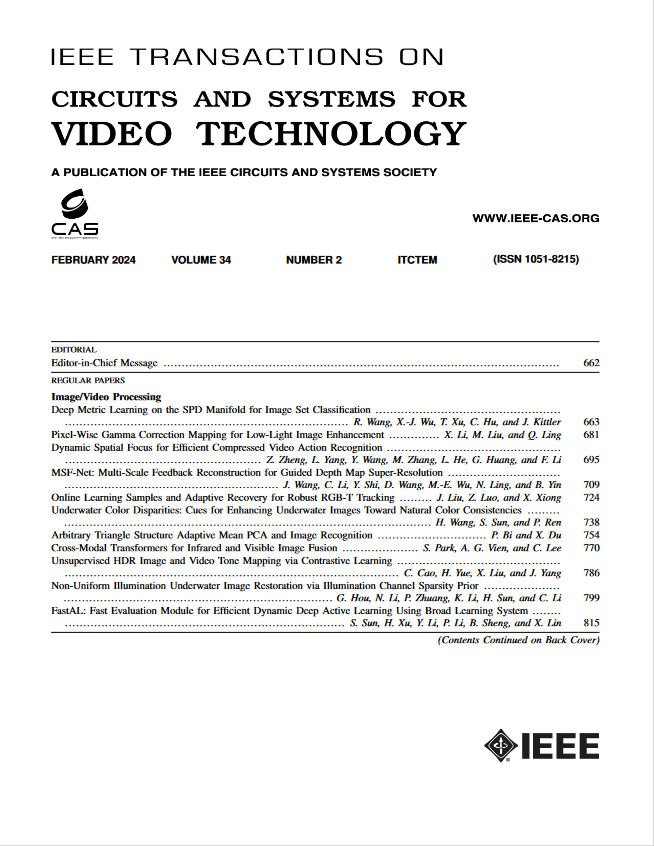Spatial Quality Oriented Rate Control for Volumetric Video Streaming via Deep Reinforcement Learning
IF 8.3
1区 工程技术
Q1 ENGINEERING, ELECTRICAL & ELECTRONIC
IEEE Transactions on Circuits and Systems for Video Technology
Pub Date : 2024-12-26
DOI:10.1109/TCSVT.2024.3523348
引用次数: 0
Abstract
Volumetric videos offer an incredibly immersive viewing experience but encounters challenges in maintaining quality of experience (QoE) due to its ultra-high bandwidth requirements. One significant challenge stems from user’s spatial interactions, potentially leading to discrepancies between transmission bitrates and the actual quality of rendered viewports. In this study, we conduct comprehensive measurement experiments to investigate the impact of six degrees of freedom information on received video quality. Our results indicate that the correlation between spatial quality and transmission bitrates is influenced by the user’s viewing distance, exhibiting variability among users. To address this, we propose a spatial quality oriented rate control system, namely sparkle, that aims to satisfy spatial quality requirements while maximizing long-term QoE for volumetric video streaming services. Leveraging richer user interaction information, we devise a tailored learning-based algorithm to enhance long-term QoE. To address the complexity brought by richer state input and precise allocation, we integrate pre-constraints derived from three-dimensional displays to intervene action selection, efficiently reducing the action space and speeding up convergence. Extensive experimental results illustrate that sparkle significantly enhances the averaged QoE by up to 29% under practical network and user tracking scenarios.基于深度强化学习的体积视频流空间质量导向速率控制
体积视频提供了令人难以置信的沉浸式观看体验,但由于其超高带宽要求,在保持体验质量(QoE)方面遇到了挑战。一个重要的挑战来自用户的空间交互,这可能导致传输比特率和渲染视口的实际质量之间的差异。在本研究中,我们进行了全面的测量实验来研究六自由度信息对接收视频质量的影响。我们的研究结果表明,空间质量和传输比特率之间的相关性受到用户观看距离的影响,在用户之间表现出可变性。为了解决这个问题,我们提出了一个以空间质量为导向的速率控制系统,即sparkle,旨在满足空间质量要求,同时最大化容量视频流媒体服务的长期QoE。利用更丰富的用户交互信息,我们设计了一个定制的基于学习的算法来提高长期的QoE。为了解决更丰富的状态输入和精确分配带来的复杂性,我们将来自三维显示的预约束融入到干预动作选择中,有效地减少了动作空间,加快了收敛速度。大量的实验结果表明,在实际网络和用户跟踪场景下,火花显著提高了平均QoE,最高可达29%。
本文章由计算机程序翻译,如有差异,请以英文原文为准。
求助全文
约1分钟内获得全文
求助全文
来源期刊
CiteScore
13.80
自引率
27.40%
发文量
660
审稿时长
5 months
期刊介绍:
The IEEE Transactions on Circuits and Systems for Video Technology (TCSVT) is dedicated to covering all aspects of video technologies from a circuits and systems perspective. We encourage submissions of general, theoretical, and application-oriented papers related to image and video acquisition, representation, presentation, and display. Additionally, we welcome contributions in areas such as processing, filtering, and transforms; analysis and synthesis; learning and understanding; compression, transmission, communication, and networking; as well as storage, retrieval, indexing, and search. Furthermore, papers focusing on hardware and software design and implementation are highly valued. Join us in advancing the field of video technology through innovative research and insights.

 求助内容:
求助内容: 应助结果提醒方式:
应助结果提醒方式:


